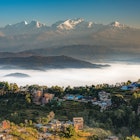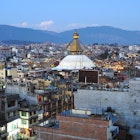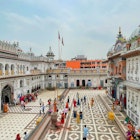
Nov 24, 2025 • 7 min read
Exploring Nepal is tempting, but not always easy. Here’s all you need to know about buses, private cars, flights and more within the Himalayan country.

Nov 24, 2025 • 7 min read
Exploring Nepal is tempting, but not always easy. Here’s all you need to know about buses, private cars, flights and more within the Himalayan country.

Nov 19, 2025 • 7 min read
Kathmandu and its surrounding areas are rich with stunning temples, architecture and scenery. Here are six must-sees from just outside the Nepalese capital.

Nov 19, 2025 • 6 min read
Lumbini in Nepal draws people – primarily pilgrims – to walk in the footsteps of the Buddha. Here's what you need to know.

Nov 15, 2025 • 7 min read
A homestay in Nepal is more than a place to crash for a night. You are truly a guest, one who participates in daily activities and gets home-cooked meals.

Nov 14, 2025 • 6 min read
From backpacking to luxury tent lodges, Nepal offers travelers on any budget an incredible range of experiences.

Nov 14, 2025 • 5 min read
Deciding to visit Nepal's thrilling landscapes is easy; getting into the country can be more complicated. Here's the lowdown on visas and fees.

Oct 1, 2025 • 5 min read
Whether you're after mountain adventures or dynamic festivals, timing is a key part of a trip to Nepal. Here's how to choose the best month for your needs.

Jun 27, 2025 • 7 min read
Discover Nepal’s top things to do in 2025: trek the Himalayas, explore cultural heritage, enjoy wildlife safaris and experience thrilling adventures.

May 15, 2025 • 10 min read
From the high Himalayas to the green foothills, Nepal offers an incomparable array of hiking trails. Here are the very best trekking routes in Nepal.

May 4, 2025 • 10 min read
Few experiences are as humbling as standing at the foot of the world’s tallest mountain. Here's what you need to know about trekking to Everest Base Camp.

Mar 13, 2025 • 7 min read
Nepal’s cuisine reflects the country’s rich cultural and geographical diversity. Here’s everything you need to try in the country.

Nov 22, 2024 • 7 min read
Gompas, monasteries housing Tibetan monks and nuns, are filled with intricate works of art and provide a vivid window into Buddhist spirituality.

Jun 26, 2024 • 9 min read
Discover Nepal's Terai, a lush paradise of vibrant culture, fertile lands, and breathtaking biodiversity. Here's what you need to know before you go.

Jun 11, 2024 • 9 min read
Experience Nepal’s Kathmandu Valley by staying in community-run homestays. Here's how to make it happen.

Feb 22, 2024 • 3 min read
Nepal's treks and trails are legendary. Here's how to choose between the Annapurna Circuit or Everest Base Camp.

Dec 20, 2023 • 7 min read
Both offer incredible mountains, deliciously spicy food and unique cultures to discover. But which should you visit?

Jan 10, 2022 • 11 min read
For the Sherpa people of Khumbu, the tourism of Mount Everest is both a livelihood and a source of unspeakable hardship.

Jan 10, 2022 • 7 min read
Kathmandu has been an essential stop on the outdoors circuit since the 1950s. Linger longer in this fascinating city.

Jan 10, 2022 • 9 min read
The trek to Everest Base Camp in Nepal is one of the world’s top adventures. Tread lightly with this sustainable guide.

Apr 9, 2021 • 7 min read
Nirmal Purja is a man of firsts. Having climbed all 14 of the world’s peaks above 8000m in one season, earlier this year his all-Nepali team…

Jan 28, 2021 • 5 min read
With suggested itineraries and ideas for alternative destinations, here's everything you need to plan your dream trip to the Himalayan region.

Dec 10, 2020 • 6 min read
Trekking to Mt. Everest Base Camp is hard - make it easier for everyone else by following these simple etiquette guidelines.